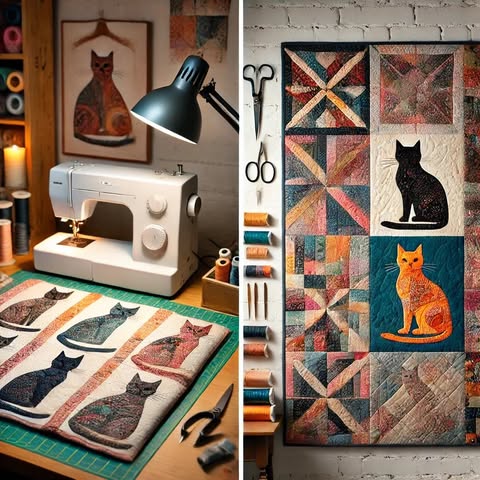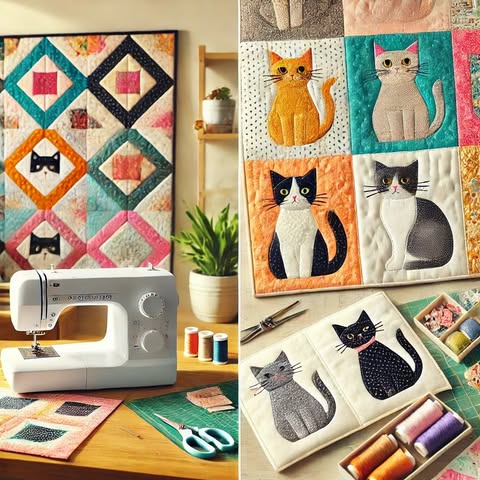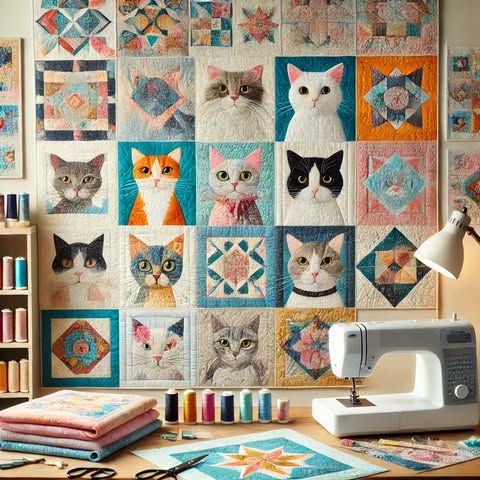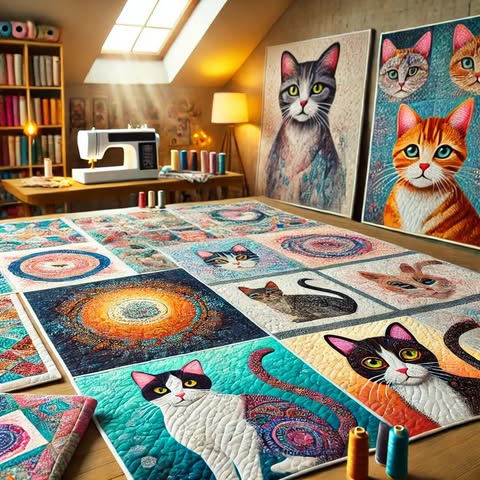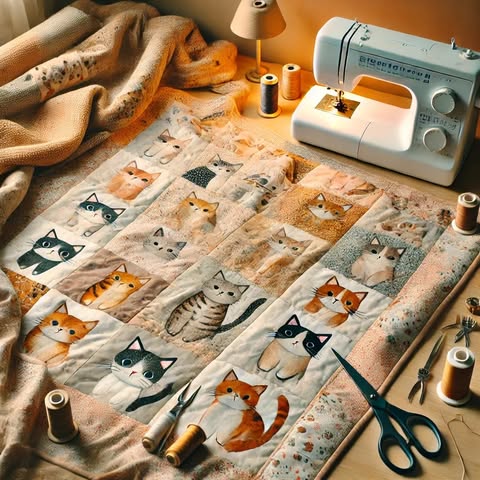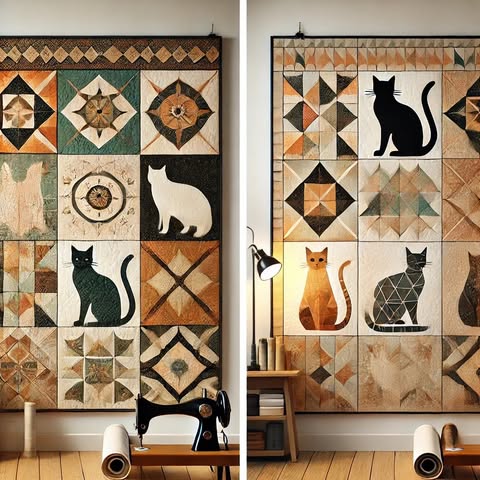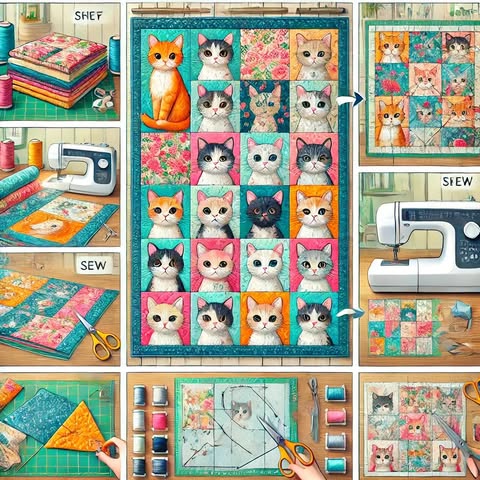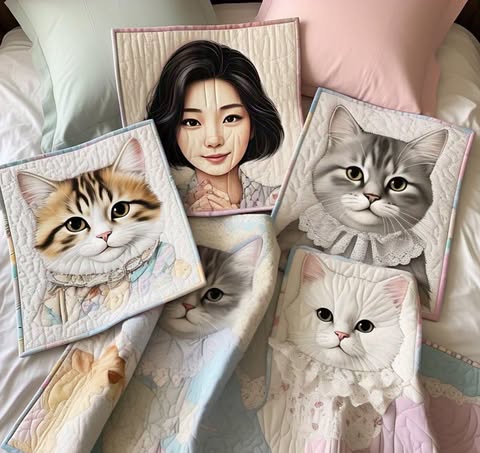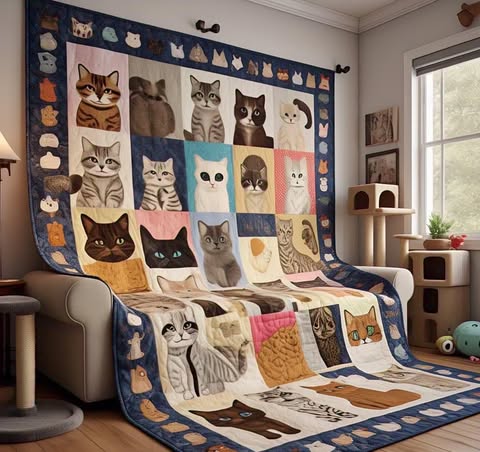Seasonal Cat Quilts: Creating Festive Designs for Every Occasion
Seasonal Cat Quilts
The Joy of Seasonal Cat Quilts
Quilting is a beloved craft that combines creativity, comfort, and tradition. For cat lovers, incorporating feline themes into quilts adds a personal and playful touch. Seasonal cat quilts take this idea further by celebrating holidays and changing seasons with charming cat-inspired designs. These quilts not only provide warmth but also serve as decorative pieces that reflect the festive spirit of different times of the year.
Creating seasonal cat quilts allows crafters to experiment with colors, patterns, and themes while paying homage to their favorite pets. Whether it’s a Halloween quilt with mischievous black cats or a cozy winter quilt featuring cats curled up by a fireplace, these designs bring joy to both the maker and the recipient.
Why Choose Seasonal Themes?
Seasonal quilts offer a unique way to mark the passage of time and celebrate special occasions. Unlike standard quilts, which may remain the same year-round, seasonal quilts can be rotated to match the current holiday or season. This keeps home décor fresh and engaging.
For cat enthusiasts, seasonal quilts provide an opportunity to showcase their pets in various festive settings. A spring quilt might feature cats playing among flowers, while a summer design could depict felines lounging in the sun. The possibilities are endless, making each quilt a one-of-a-kind masterpiece.
Getting Started with Seasonal Cat Quilts
Before diving into a seasonal cat quilt project, it’s essential to plan the design carefully. Beginners should start with simpler patterns and gradually move to more complex ones as their skills improve. Key considerations include:
Choosing the Right Fabric
Seasonal quilts rely heavily on fabric choices to convey the right mood. Bright, pastel colors work well for spring, while rich reds and greens are perfect for Christmas. Halloween quilts often feature oranges, blacks, and purples. Cat-themed fabrics with paw prints, silhouettes, or playful kitten designs can enhance the overall theme.
Selecting a Pattern
Patterns for seasonal cat quilts can range from traditional block designs to more modern, artistic layouts. Some quilters prefer appliqué techniques to add detailed cat shapes, while others opt for pieced patterns that create abstract feline forms. Free-motion quilting can also be used to add texture, such as stitching whiskers or fur details.
Planning for Durability
Since seasonal quilts may be stored and brought out only during specific times of the year, they should be made with durable materials. High-quality cotton fabric is a popular choice because it is easy to work with and holds up well over time. Proper stitching and binding ensure the quilt withstands years of use and storage.
Seasonal cat quilts are a delightful way to combine a love for quilting with a passion for felines. By carefully selecting fabrics, patterns, and techniques, quilters can create stunning pieces that celebrate holidays and changing seasons. The next part will explore spring and summer-themed cat quilts, offering inspiration and practical tips for crafting these cheerful designs.
Spring and Summer Cat Quilts
Welcoming Spring with Feline Charm
Spring is a time of renewal, and what better way to celebrate than with a quilt featuring playful cats among blooming flowers? Spring-themed cat quilts often incorporate pastel colors, floral prints, and whimsical designs that capture the season’s cheerful energy.
One popular design idea is a quilt with appliquéd cats chasing butterflies or lounging in garden scenes. Lightweight fabrics such as cotton or linen work well for spring quilts, ensuring they provide just enough warmth without being too heavy.
Design Ideas for Spring Cat Quilts
A common approach is to use a mix of solid and patterned fabrics to create contrast. For example, a quilt might have a soft green background with appliquéd cats made from floral fabric. Another option is a patchwork quilt where each block features a different cat pose surrounded by spring motifs like daisies, tulips, or raindrops.
Quilters can also experiment with embroidery to add fine details, such as stitching tiny bees or birds near the cats. This adds depth and personality to the design, making the quilt feel more dynamic.
Bright and Playful Summer Cat Quilts
Summer quilts often feature vibrant colors and relaxed themes, such as cats napping in the sun or playing at the beach. These quilts can be lighter in weight, making them perfect for picnics or as decorative throws during warm months.
Incorporating Summer Themes
A fun summer quilt idea is a “beach day” design, where cats are depicted with sunglasses, tiny surfboards, or even fishing by a pond. Bright blues, yellows, and sandy neutrals help convey the essence of summer. Striped or polka-dot fabrics can add a playful touch.
Another approach is a “garden party” quilt, where cats are shown lounging under umbrellas or surrounded by watermelon slices. These lighthearted designs bring a sense of joy and relaxation, perfect for the carefree days of summer.
Choosing the Right Techniques
For summer quilts, quilters might opt for simpler piecing methods to keep the project manageable in the heat. Large, bold blocks with minimal intricate stitching can make the process faster while still creating a visually appealing result. Alternatively, using pre-printed cat-themed panels can save time while maintaining a high level of detail.
Spring and summer cat quilts offer endless opportunities for creativity, blending seasonal motifs with adorable feline elements. Whether through appliqué, embroidery, or bold fabric choices, these quilts capture the essence of warmer months. The next part will delve into autumn and Halloween-themed cat quilts, exploring spooky and cozy designs perfect for fall.
Autumn and Halloween Cat Quilts
Embracing the Cozy Spirit of Autumn
As the leaves change color and the air turns crisp, autumn-themed cat quilts bring warmth and charm to any home. This season is perfect for rich, earthy tones like deep oranges, browns, and golden yellows, evoking the beauty of falling leaves and harvest time. Cats, with their natural affinity for cozy spots, fit wonderfully into autumn quilt designs—whether curled up in a pumpkin patch or playfully batting at falling leaves.
Autumn cat quilts often feature rustic patterns and textures, making them ideal for snuggling under during cooler evenings. The combination of seasonal motifs and feline charm creates a quilt that is both decorative and functional.
Designing an Autumn-Themed Cat Quilt
One popular approach is to create a scene where cats interact with classic autumn elements. A quilt might depict a patchwork of quilt blocks, each showing a cat in a different fall setting—perched on a hay bale, hiding among pumpkins, or napping under a tree with colorful leaves. Appliqué techniques work well for adding detailed cat silhouettes, while embroidery can enhance the design with delicate leaf veins or tiny acorns.
Another idea is to use a gradient fabric background that transitions from green to orange to brown, mimicking the changing seasons. Cats can be appliquéd or pieced into the design, appearing as if they are wandering through an autumn forest.
Fabric Choices for Autumn Quilts
When selecting fabrics, quilters should consider materials that reflect the warmth of the season. Flannel, wool blends, or heavier cotton can add extra coziness, making the quilt perfect for chilly nights. Prints with plaid, leaves, or subtle woodland patterns complement the theme without overwhelming the design. For a more whimsical touch, novelty fabrics featuring cartoon cats in scarves or sitting in piles of leaves can add personality.
Halloween Cat Quilts: Spooky and Playful Designs
Halloween is a favorite holiday for many quilters, and cat-themed designs are a natural fit. Black cats, with their association with mystery and superstition, take center stage in Halloween quilts. These projects allow for bold contrasts, eerie motifs, and a playful mix of spooky and cute elements.
Classic Halloween Imagery with a Feline Twist
A traditional Halloween quilt might feature black cat silhouettes against a moonlit sky, surrounded by bats, witches’ hats, and jack-o’-lanterns. Orange and black are the dominant colors, but deep purples and greens can add extra vibrancy.
For a more lighthearted take, a quilt could showcase cartoon-style cats dressed in Halloween costumes—tiny witches, vampires, or even pumpkins. This approach is especially great for children’s quilts or those who prefer a less eerie aesthetic.
Creative Techniques for Halloween Quilts
To add texture and dimension, quilters can experiment with:
- Glow-in-the-dark thread for subtle, spooky accents on moons or cats’ eyes.
- Faux fur fabric for appliquéd black cats, giving them a tactile, realistic feel.
- Bold, graphic piecing to create optical illusions, like a cat’s eyes glowing in the dark.
Another fun idea is a “haunted house” quilt, where each window or door reveals a different cat peeking out. This interactive design makes the quilt engaging and visually dynamic.
Autumn and Halloween cat quilts offer a wonderful opportunity to blend seasonal coziness with playful feline themes. Whether opting for rustic autumn scenes or spooky Halloween motifs, these quilts bring warmth and character to any home. The final part will explore winter and Christmas cat quilts, featuring festive designs perfect for the holiday season.
Winter and Christmas Cat Quilts
Celebrating the Magic of Winter with Feline Friends
As the year winds down and temperatures drop, winter-themed cat quilts bring warmth, charm, and festive cheer to any home. This season invites rich, icy blues, sparkling whites, and deep evergreen hues—colors that naturally complement cozy feline imagery. Whether depicting cats curled up by a fireplace, playing in freshly fallen snow, or wearing tiny holiday scarves, winter cat quilts capture the serene beauty and joyful spirit of the season.
Unlike other seasonal quilts, winter designs often emphasize comfort and nostalgia. The quilt becomes more than just a decorative piece; it transforms into a cherished heirloom, evoking memories of snowy days and holiday gatherings.
Designing a Winter Wonderland Cat Quilt
One popular approach is to create a snowy landscape quilt where cats are the main characters. A scene might feature:
- Silhouetted cats prancing across a moonlit snowscape, their paw prints trailing behind them.
- A cozy indoor setting with cats napping near a decorated Christmas tree or perched on a windowsill watching snowflakes fall.
- Playful winter activities, such as cats batting at ornaments, tangled in yarn, or even “ice skating” on a frozen pond (with tiny fabric skates added for whimsy).
For quilters who prefer abstract designs, a geometric pattern in cool blues and whites can suggest icy winds, with cat shapes subtly integrated into the piecing. Appliqué works beautifully for adding detailed elements like scarves, ear muffs, or even tiny holiday sweaters onto feline figures.
Fabric and Embellishments for Winter Quilts
Texture plays a key role in winter quilts. Consider these fabric choices:
- Minky or fleece for backing, adding extra softness and warmth.
- Metallic or shimmer fabrics to mimic frost and snow.
- Felted wool accents for dimensional elements like snowflakes or cat ears.
Embellishments can elevate the design:
- Beads or sequins sewn onto snowflakes or cat collars for a touch of sparkle.
- Embroidery to add delicate details like falling snow or intricate patterns on holiday stockings.
- Faux fur trims for a tactile, luxurious feel—perfect for cat tails or Santa hats.
Christmas Cat Quilts: Festive and Whimsical Designs
Christmas is a time of vibrant colors, nostalgic imagery, and playful themes—making it ideal for cat-loving quilters. From traditional red-and-green palettes to modern pastel holiday schemes, Christmas cat quilts can range from elegant to humorous.
Classic Christmas Themes with a Feline Twist
A timeless design might feature:
- Cats nestled among presents under a tree, with quilted ribbons and bows adding dimension.
- A “Santa’s Workshop” quilt, where cats take on the roles of elves, complete with tiny tools and festive outfits.
- A Nativity parody, with cats standing in for the traditional figures (a humorous touch for secular quilters).
For a more sophisticated look, a quilt could use a deep red or green background with gold-thread embroidery outlining stylized cat shapes in Art Deco or Victorian-inspired patterns.
Creative Techniques for Christmas Quilts
To make the quilt stand out:
- Layer sheer fabrics over solid colors to create the illusion of stained-glass windows (perfect for a “Christmas church tabby” theme).
- Use fabric paint to add tiny paw prints “walking” across the quilt’s border.
- Incorporate pockets into the design, allowing small ornaments or treats to be tucked inside as interactive elements.
For quilters short on time, a “quilt-as-you-go” method with pre-printed Christmas cat panels can simplify the process while still delivering a stunning result.
Conclusion: The Year-Round Joy of Seasonal Cat Quilts
From spring blossoms to winter snowfalls, seasonal cat quilts offer a delightful way to celebrate the changing year while honoring the whimsy and warmth of feline companions. Each season brings new inspiration—whether it’s the playful energy of summer, the spooky fun of Halloween, or the quiet coziness of winter.
These quilts do more than keep us warm; they tell stories, spark joy, and become treasured pieces of home. By experimenting with fabrics, techniques, and themes, quilters can create a rotating collection that reflects their love for cats and the seasons alike.
Whether you’re a beginner or an experienced quilter, there’s always a new design to try—a new way to stitch together the things you love. So pick up your needle, choose your fabrics, and let the seasons (and the cats) guide your creativity. Happy quilting!

